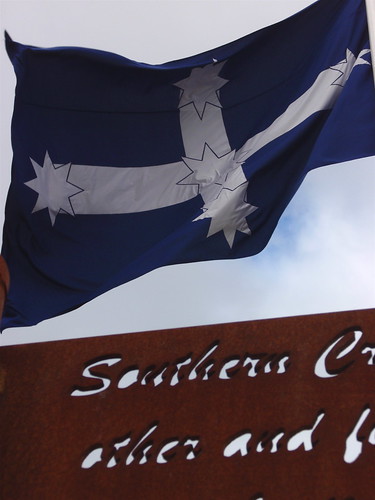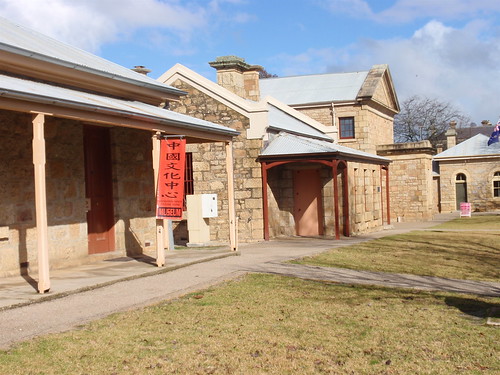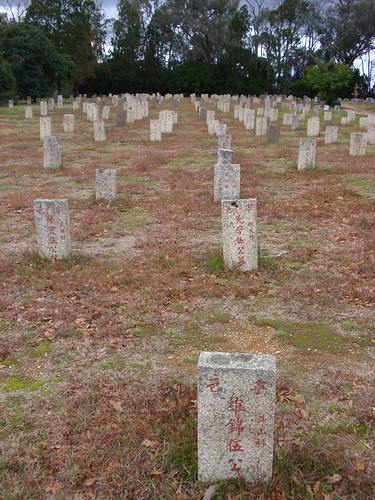We visited the Eureka Centre in Ballarat - a museum constructed near the site on which the Eureka Stockade was erected in December 1854.

All Australian children learn at primary school that the Eureka Rebellion signaled the birth of democracy in the Australian colonies. Of course this is a simplification, but the stand of 150 miners against the Government's collection of steep mining license fees was about something more than self-interest. A broad movement for reform preceded the rebellion, often influenced by the Chartists in Britain and revolutionary movements in Europe, which demanded some form of broader representation in the country's decision-making.
The battle at the Eureka Stockade was brief and brutal with around 30 miners' deaths. I couldn't help but be moved by the miners' oath
We swear by the Southern Cross to stand truly by each other and fight to defend our rights and liberties.Perhaps ironically, the aftermath of the rebellion was support from the broader community, reduction in the license fees and a failure of the legal system to convict any of the rebels of the high treason with which they were charged. Peter Lalor, the leader of the rebels, became a politician and speaker of the Victorian Legislative Assembly.
Even though the rebels at the Eureka Stockade came from a range of birth countries (including Australia), notably, none were Chinese. The history of Chinese miners on the Australian goldfields is troubling and disturbing. I grew up near the town of Young in New South Wales, and have always been aware of the brutal attacks on Chinese miners at Lambing Flat, just outside Young, but until I visited the small Chinese Museum in BeechworthI'd never heard of the 1857 Buckland Riots, in which Chinese miners were driven from the goldfields near Beechworth and their property destroyed.

Despite such violent confrontations, it's claimed that at the peak of the gold rush, more than 5,000 Chinese miners lived in the Beechworth area and developed their own market gardens, shops and temple. I don't know enough to know whether such community separation was enforced, or undertaken voluntarily, or whether such distinctions were possible at that time. The cemetery at Beechworth has a moving memorial to the Chinese miners with a field of headstones and 'burning towers' used for ceremonial purposes.

But there is no Chinese presence in Beechworth today. I can't help but wonder what happened to all the miners and descendants of the miners who were in central Victoria in the mid nineteenth century.
No story of insurrection in Australia would be complete without a mention of Ned Kelly. North-east Victoria is self-proclaimed 'Kelly Country' and we found reminders of his presence in many places. In Chiltern we were informed that the first warrant for his arrest was issued in the Chiltern courthouse. In Beechworth we stayed in a motel next to a memorial celebrating a 20 round bare-knuckle fight in which nineteen year old Kelly had been the victor. Beechworth Gaol was where Ned's mother, Ellen Kelly, was sentenced to three years hard labour for the attempted murder of a policeman (Ned clearly came from feisty Irish stock), and Beechworth Courthouse was where Kelly's committal hearing was held in 1880.
With all this history around us, we couldn't resist a visit to Glenrowan, site of the Kelly gang's infamously bloody stand against the Victoran troopers. The main street of the small town of Glenrowan is crammed with tatty souvenirs and garish 'experiences' for the tourist. But if you cross the railway line behind the main street you come to a small park and vacant block of land which is the location of the confrontation. Here, assistance for the tourist is more subtle and there are plaques describing the stages of the siege.

The white sign in the top right of the photo is the location of the Glenrowan pub where the Kelly gang held hostages and made their stand. The small gully in the centre of the photograph is where the troopers gathered and fired from. The scale is so small and the setting so ordinary for an event from which so many national myths have been constructed. I hadn't known that the troopers travelled by train to arrest Ned and his companions, and that they brought with them a contingent of reporters to observe and spread the news of an event that excited so much contemporary public interest. Perhaps an early example of the media being embedded with the troops? The reporters and general gawpers and observers took shelter in the tiny railway station, only about twenty meters from where the siege occurred.

Unlike the Glenrowan pub, which was immediately burnt by the troopers after Ned Kelly was arrested, the station still stands and has been preserved in its simplicity.
Victoria has a proud tradition of civic achievement, but the underside of that is the history of insurrection that is sometimes mythologised, and often forgotten in modern Australia. Ah well, such is life, as Ned is reputed to have said just before he was hanged.
3 comments:
Another interesting set of reflections on our history, thanks Lyn!
its a very historic area isnt it, the whole of victoria. sydney siders like to think it all happened up here, but it really didnt! hope everything is going well offline!
Thank you Lyn for the thoughtful history lesson.
I am so impressed that you are able to post such informative posts when you must be extraordinarily busy with other things! Hope it's all going well.
Post a Comment